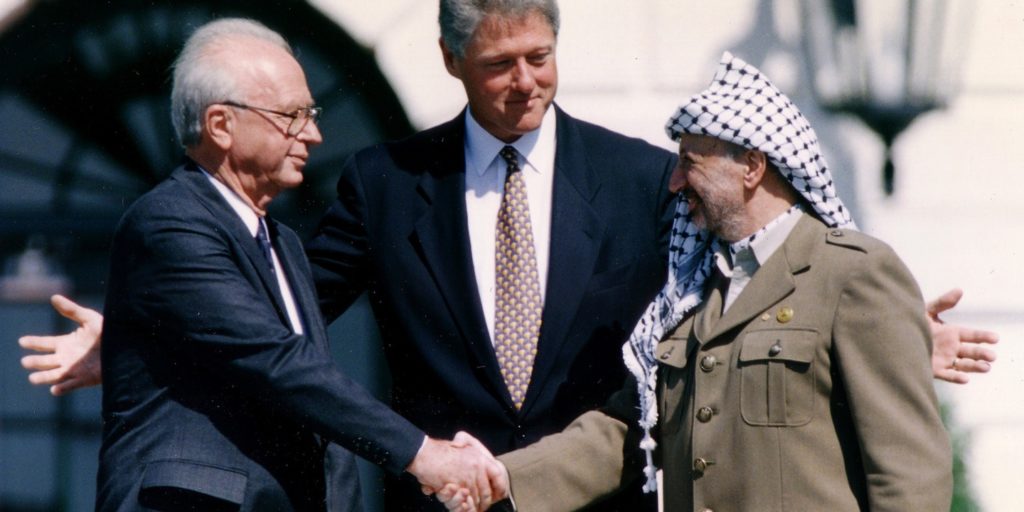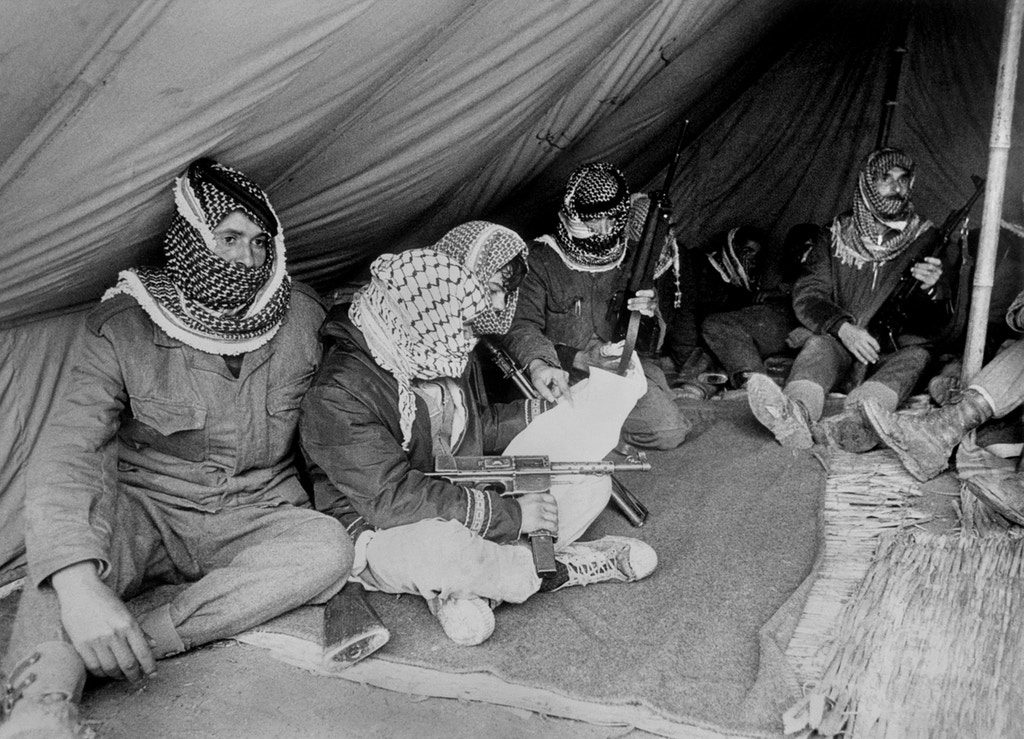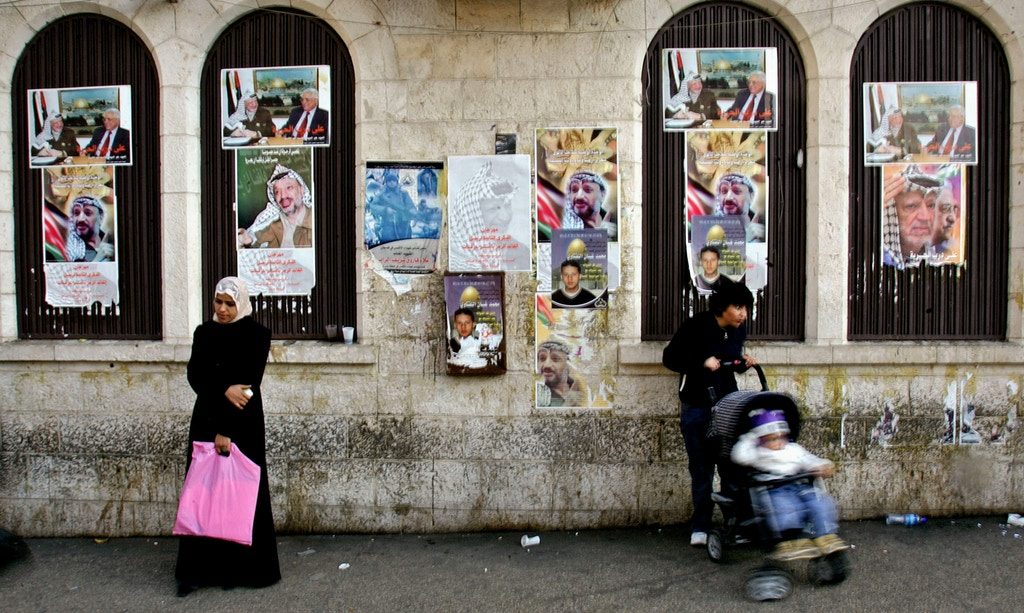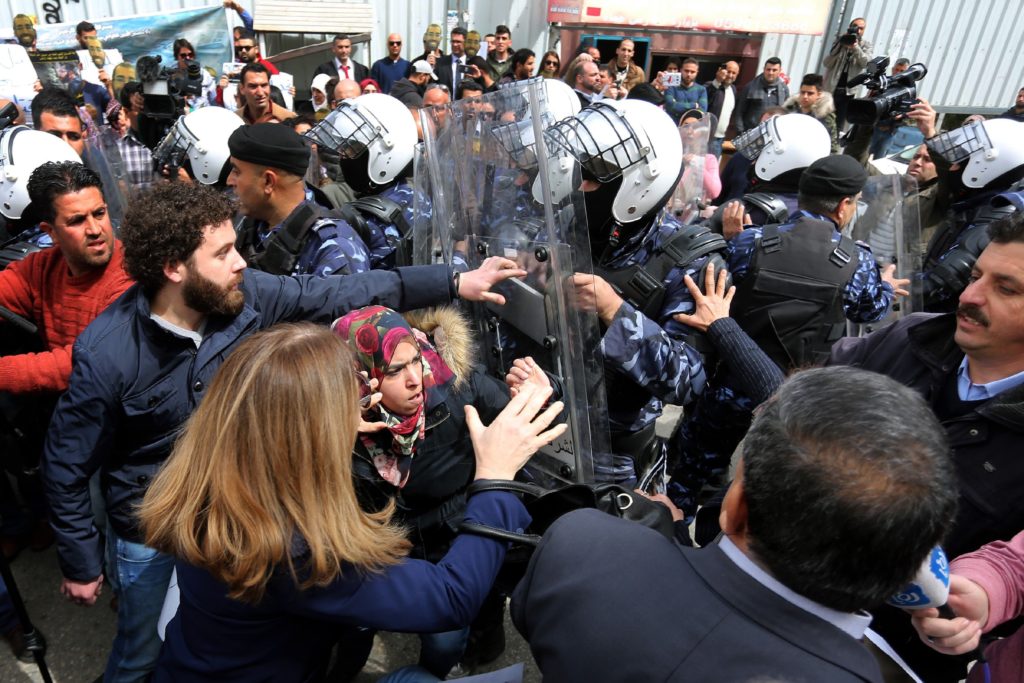No One Will Be Celebrating the 25th Anniversary of the Oslo Accords
PALESTINE - ISRAEL, 17 Sep 2018
Jon Schwarz and Alice Speri – The Intercept

PLO Chair Yasser Arafat, right, shakes hands with Israeli Prime Minister Yitzhak Rabin as U.S. President Bill Clinton stands between them, after the signing of the Israeli-PLO peace accord at the White House on Sept. 13, 1993.
Photo: Gary Hershorn/Reuters
13 Sep 2018 – On September 13, 1993, Israel and the Palestinian Liberation Organization signed the Oslo Accords on the lawn of the White House. Following some nudging from U.S. President Bill Clinton, Israeli Prime Minister Yitzhak Rabin and PLO Chair Yasser Arafat shook hands, thrilling the 3,000 assembled potentates.
The New York Times marked the occasion with a banner A1 headline, and the accompanying story by Thomas Friedman described Oslo as an “agreement between Jews and Palestinians to end their conflict” — “a triumph of hope over history.” The Times devoted its whole front page to the accord; another article referred to it as a “Day of Glory.” The Washington Post’s lead story was headlined “Ritual End To Decades Of Conflict.” Within a year Rabin, Arafat, and then-Israeli Foreign Minister Shimon Peres would win the Nobel Peace Prize.
Meanwhile, critics of the agreement, formally called a “Declaration of Principles on Interim Self-Government Arrangements,” were completely drowned out in the euphoria.
The late Edward Said, the most articulate champion of the Palestinian cause in the United States, immediately called Oslo “an instrument of Palestinian surrender.” Said quoted Israeli novelist Amos Oz as saying it was “the second-biggest victory in the history of Zionism,” after the establishment of Israel in 1948. Few would herald Said in the moment, but his criticisms have been more than borne out.
Oslo merely required Israel to recognize the PLO as the representative of the Palestinian people and pull back troops from parts of the occupied territories that Israel was happy to cede to soon-to-be formed Palestinian security forces. Managing civil affairs in densely populated Palestinian cities that Israel had no interest in keeping was a headache anyway.
Negotiations on everything important — “Jerusalem, refugees, settlements, security arrangements, borders, relations and cooperation with other neighbors” — were left to a “five year transitional period,” with no incentives for Israel to concede anything, including statehood, to the Palestinians. This “interim stage” purportedly leading to Palestinian self-government, Said wrote, “may be the final one.”
Who was right? Who was wrong? The answer is obvious from the silence this week of Oslo’s proponents — on the 25th anniversary of the accord. There are no op-eds from former State Department officials congratulating themselves on their hard work and diligence. Bill Clinton has not taken to Twitter to reminisce about that hallowed day.
They all realize, of course, that it would be ridiculous if they did. Today there is no Palestinian state, no peace — and no sign there ever will be either. Since Oslo, about 10,000 Palestinians have been killed by Israel, several thousand of them women and children, and more than 1,500 Israelis have been killed by Palestinians. The West Bank and Gaza have been politically severed from each other, even as the number of Israeli settlers has grown from about 250,000 in 1993 to 600,000 today. And the Israeli government and populace have grown more and more extreme, to the point that Prime Minister Benjamin Netanyahu, who once was seen as occupying the far-right of the political spectrum, now is part of the sensible center.
“It’s not that the PA has turned into a monster, I think it was born a monster.”
Worst of all from the perspective of Palestinians, 25 years after Oslo they do not have legitimate political representation. Said predicted in 1993 that the PLO would “become Israel’s enforcer, an unhappy prospect for most Palestinians.” This is exactly what has come to pass: The Palestinian Authority, set up after Oslo as the supposedly interim self-governing body for Palestinians, is largely a corrupt agent of the Israeli government.
This is no surprise to Palestinians. “It’s not that the PA has turned into a monster, I think it was born a monster,” Yara Hawari, a young activist and a policy fellow at the Palestinian think tank Al-Shabaka, told The Intercept this summer. “I don’t think it was ever going to be anything else just because of the way that it was set up: What it was supposed to do was maintain and manage the situation and assist it.”
“It’s classic Fanon if you think about it,” Hawari said. “It’s like, Let’s create this class of people that are going to maintain the security of the oppressed or the natives, so that we don’t have to do it.”
The illusion in the U.S. since Oslo has been that the situation is a struggle between Israelis and Palestinians. In fact, it is largely a conflict between Palestinians on the one hand, and Israel, the U.S., and the Palestinian Authority on the other.

Fatah militiamen rest under a tent near the Jordan River in Jordan on Nov. 4, 1969. Photo: AFP/Getty Images
To understand how this came to pass requires a look back at Palestinian and Israeli history.
The PLO was founded in Cairo in 1964, with the goal of “the liberation of Palestine” — i.e., the elimination of Israel. Then in 1967, Israel attacked its Arab neighbors and seized huge amounts of territory: the Sinai Peninsula and Gaza (from Egypt), the West Bank (from Jordan), and the Golan Heights (from Syria). Israel returned the Sinai to Egypt as part of the Camp David Accords in 1978, but its continued possession of the West Bank and Gaza meant that it was ruling directly over millions of Palestinians.
The PLO conceived of itself as a government in exile, with its main headquarters as of 1970 in Jordan. However, conflict with Jordan’s King Hussein led the PLO’s various factions to relocate to Lebanon over the next several years. Israel’s 1982 invasion of Lebanon then forced the PLO to again pull up stakes and move to Tunis, the capital of Tunisia.
During the 1970s, the PLO’s goals moderated. According to a 1977 State Department memo, Arafat strenuously argued to a U.S. diplomat that the PLO had already reached “tacit acceptance of [a] two-state solution” — that is, a solution to the conflict in which Israel would withdraw from Gaza and the West Bank, and they would become the territory for a new Palestinian state. Two resolutions calling for a two-state solution were introduced in the U.N. Security Council during this period; the U.S. vetoed both.
However, the PLO steadily weakened during the 1980s after its relocation to Tunis. Part of it was simply distance: It’s almost 1,500 miles from Tunis to Jerusalem, about as far as it is from New York City to Lubbock, Texas. Part of it was the PLO’s deep flaws: Noam Chomsky has described how “the corruption of the PLO has just infuriated Palestinians in the Territories. … Back in 1988 or so, and when you went into, say, the old city of Nablus, or villages, and talked to organizers or activists, their hatred and contempt of the PLO was just extraordinary.” Part of it was the First Intifada, a Palestinian uprising that began in 1987 and was led not by the PLO’s far-away, aging men, but mostly women who actually lived in Palestine and, for the first time, didn’t wait for guidance from their exiled leaders.
Then most damagingly, Arafat foolishly backed Saddam Hussein during the first Gulf War, in 1991. This angered the PLO’s patrons in other petrostates, which cut off funding. The PLO was now near collapse — leading Israeli military intelligence to advise Yitzhak Rabin that this made them the perfect partner for “peace.”
This is why the Oslo Accords were signed: Everyone significant got something they wanted. Israel got the chance to kick the legs out from under the surprisingly successful intifada and subcontract much of the occupation to PLO elites. The PLO and Arafat got the opportunity to become players again just as their power had been slipping away. And the U.S. was able to stabilize the situation for a client state — plus get a beautiful White House photo op.
Of course, regular, powerless Palestinians got something too. Danny Rubinstein, an analyst for the liberal Israeli daily Haaretz, described it as “autonomy,” but “autonomy as in a POW camp, where the prisoners are ‘autonomous’ to cook their meals without interference and to organize cultural events.”
For most Palestinians living in the occupied territories, the arrangement set up under the Oslo Accords is all they’ve ever known. More residents of the West Bank and Gaza were born after 1993 than before. In Gaza, nearly 40 percent of the population is under 14 years old.
Unsurprisingly, the Palestinian Authority’s legitimacy has been increasingly challenged, mostly by young Palestinians who see it as an additional layer to their oppression — on top of the Israeli occupation to which the PA is inexorably tied.

Portraits of Yasser Arafat and Palestinian President Mahmoud Abbas hang on a wall, in the West Bank town of Ramallah on Dec. 4, 2006. Photo: Muhammed Muheisen/AP
The last Palestinian legislative elections were held in 2006, with the encouragement of the George W. Bush administration. Hamas, the more radical Islamist organization based in Gaza, won — not necessarily because Palestinians supported all their policies, but because of their reputation for being less corrupt than Fatah, the remnants of the PLO. Hillary Clinton, then a senator from New York, was stunned by Bush’s naiveté. “I do not think we should have pushed for an election in the Palestinian territories,” she said. “And if we were going to push for an election, then we should have made sure that we did something to determine who was going to win.”
The Bush administration clearly came around to Clinton’s perspective in the election’s aftermath. With Secretary of State Condoleezza Rice taking the lead, the administration attempted to organize a coup in which Fatah would overthrow the elected government. In response, Hamas seized control of Gaza, while Fatah retained power in the West Bank, a stalemate that remains in place to this day.
Meanwhile, Fatah’s Mahmoud Abbas continues to serve as president of the Palestinian Authority. Abbas, who was first elected in 2005 after Arafat’s death, should have faced another election when his term ended in 2009. Instead he has stayed in office indefinitely.
Recent years have seen greater and greater tensions between Palestinians, mostly the young, and their leadership. In 2017, protests erupted after the prominent Palestinian activist Bassel Al-Araj was killed by Israeli forces after being detained a year earlier by Palestinian security forces. The PA brutally repressed the demonstrations. Abbas said at the time, “Our security cooperation with Israel is functioning well.”
Al-Araj’s death sparked widespread condemnation of the PA, with demonstrators in the street calling him a martyr not just of the occupation, a common refrain, but also of the “security coordination.”

Security forces clash with protesters outside the Ramallah Minor Court in Ramallah, West Bank, on March 12, 2017, after Palestinian activist Bassel Al-Araj was killed. Photo: Issam Rimawi/Anadolu Agency/Getty Images
Then, last June, Palestinians once again took to the streets to protest a set of sanctions that the Palestinian Authority had imposed on Gaza, including slashing the salaries of government employees there and forcing a third into early retirement.
In Ramallah, hundreds of protesters were met with tear gas and stun grenades from a wide array of security officers in uniform and riot gear. The Palestinian Authority, which had forbidden the protest before it started, ordered it shut down. More than 40 people were arrested, and many were beaten and injured. In subsequent smaller demonstrations, security forces sometimes outnumbered protesters 10 to one.
“Many feel, Why would we criticize the PA when we can criticize Israel? But that’s just not a very nuanced understanding of what occupation means.”
Several people who were in Ramallah when the June protest was met with violence later told The Intercept that they originally thought the Israeli army had entered the city before realizing the security officers were “our own guys,” as one protester put it. Others said the display of force was reminiscent of that of Arab regimes in Syria and Egypt, and quietly warned about the Palestinian Authority’s descent into authoritarianism.
“People, even people high up, were very, very pissed off with the way that it was handled because it made the PA look like a very repressive body,” said Hawari, the activist. “Which it is.”
“Many feel, Why would we criticize the PA when we can criticize Israel?” said Hawari. “People will say that’s very divisive, and the main problem is the occupation, and we need to focus on the enemy. But that’s just not a very nuanced understanding of what occupation means.”
“Of course that’s not to say the main reason isn’t the occupation,” she added, “but the PA is a huge barrier in the way of liberation.”
If anger at the Palestinian Authority’s leadership is most noticeable among young Palestinians, members of older generations who experienced the occupation pre-Oslo feel deep resentment as well.
Qadura Fares, head of the Palestinian Prisoners Club and a close friend of imprisoned Palestinian leader Marwan Barghouti, spent 13 years in an Israeli prison for his political work. He was released as part of the Oslo process, along with other Palestinian political activists.
“We agreed and signed with the Israelis that these procedures should lead to the end of the occupation, and to create a new state beside Israel, living together in peace and cooperation,” he said, without masking his sarcasm, during an interview in Ramallah over the summer.
“You can keep saying that you represent the interest of the people,” he told The Intercept, “but your behavior is saying different things.” He compared the power and wealth enjoyed by Palestinian leaders to that of the authoritarian monarchs of the Persian Gulf. “If we could make real democracy happen in our life, we will win the battle with the occupation,” he added. “But if we don’t succeed to be a real democratic community, it’s a sign that we will not be a free Palestine.”
If the Palestinian Authority needs to die in order for Palestinians to pursue their liberation, the Trump administration may just have inadvertently brought its demise a step closer. Earlier this week, the U.S. State Department shut down the PLO’s mission in Washington, D.C., accusing the Palestinian body of refusing to engage with the U.S. and not having “taken steps to advance the start of direct and meaningful negotiations with Israel.” The Palestinian Authority called the move “a declaration of war on efforts to bring peace to our country and the region.”
For now — and for the foreseeable future — Edward Said’s warning about Oslo appears hauntingly accurate. For the Palestinians to “throw themselves on the tender mercies of the U.S.,” he wrote, “is almost certainly to suffer the fate the U.S. has meted out to rebellious or ‘terrorist’ peoples it has had to deal with in the Third World after they have promised not to resist the U.S. any more.”
__________________________________________
Jon Schwarz – jon.schwarz@theintercept.com
Alice Speri – alice.speri@theintercept.com
Go to Original – theintercept.com
Join the BDS-BOYCOTT, DIVESTMENT, SANCTIONS campaign to protest the Israeli barbaric siege of Gaza, illegal occupation of the Palestine nation’s territory, the apartheid wall, its inhuman and degrading treatment of the Palestinian people, and the more than 7,000 Palestinian men, women, elderly and children arbitrarily locked up in Israeli prisons.
DON’T BUY PRODUCTS WHOSE BARCODE STARTS WITH 729, which indicates that it is produced in Israel. DO YOUR PART! MAKE A DIFFERENCE!
7 2 9: BOYCOTT FOR JUSTICE!
DISCLAIMER: The statements, views and opinions expressed in pieces republished here are solely those of the authors and do not necessarily represent those of TMS. In accordance with title 17 U.S.C. section 107, this material is distributed without profit to those who have expressed a prior interest in receiving the included information for research and educational purposes. TMS has no affiliation whatsoever with the originator of this article nor is TMS endorsed or sponsored by the originator. “GO TO ORIGINAL” links are provided as a convenience to our readers and allow for verification of authenticity. However, as originating pages are often updated by their originating host sites, the versions posted may not match the versions our readers view when clicking the “GO TO ORIGINAL” links. This site contains copyrighted material the use of which has not always been specifically authorized by the copyright owner. We are making such material available in our efforts to advance understanding of environmental, political, human rights, economic, democracy, scientific, and social justice issues, etc. We believe this constitutes a ‘fair use’ of any such copyrighted material as provided for in section 107 of the US Copyright Law. In accordance with Title 17 U.S.C. Section 107, the material on this site is distributed without profit to those who have expressed a prior interest in receiving the included information for research and educational purposes. For more information go to: http://www.law.cornell.edu/uscode/17/107.shtml. If you wish to use copyrighted material from this site for purposes of your own that go beyond ‘fair use’, you must obtain permission from the copyright owner.
Read more
Click here to go to the current weekly digest or pick another article:
PALESTINE - ISRAEL: